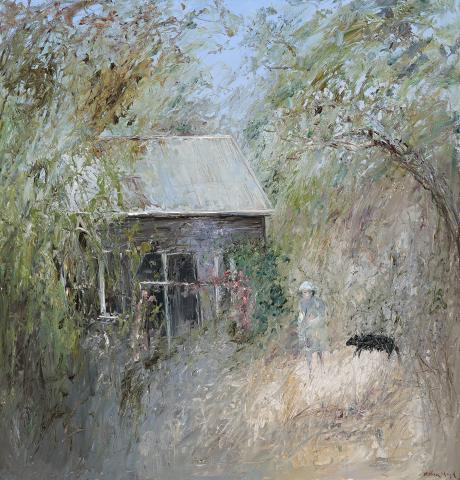THE HOUSE AT MURRUMBEENA, c.1964 - 67
ARTHUR BOYD
oil on canvas
113.0 x 108.0 cm
signed lower right: Arthur Boyd
Johnstone Gallery, Brisbane
Roy and Nancy Melick, Sydney
Estate of Nancy Melick OAM, Sydney
Arthur Boyd, The Johnstone Gallery, Brisbane, 10 – 23 August 1969, cat. 11 (as ‘The House at Murrumbeena’)
Hoff, U., The Art of Arthur Boyd, Andre Deutsch, London, 1986, p. 244 (illus. pl. 95 as ‘Potter’s House at Murrumbeena, 1964 – 67’)
Depicting an intimate and cherished scene from Arthur Boyd’s childhood, The House at Murrumbeena, 1964-67, is a commemorative portrayal of the Boyd family home in Murrumbeena, a suburb on the outskirts of eastern Melbourne.1 The picture on offer forms part of Boyd’s Potters Series of the 1960s, a poignant homage to his father Merric who died in 1959 and his mother Doris who passed away in the following year. The loss of his parents prompted Boyd to revisit and explore the nurturing environment of his youth and the profound influence of his parents, by capturing moments of their everyday life. Open Country, as the family home was fondly named, provided a supportive atmosphere and was frequented by many of Melbourne’s artistic circle including Albert Tucker, Joy Hester and Sidney Nolan.2 This melting pot of cultural ideas and creativity made a lasting impression on Boyd and he thus developed a strong attachment to the house at Murrumbeena.
The Potter Series is a rather idyllic and private component of Boyd’s oeuvre, particularly when compared to the Nebuchadnezzar series which was created at the same time. Contrasted against the powerful and somewhat disturbing portrayals of the Babylonian king Nebuchadnezzar, who was banished to the wilderness for placing his own vanity and egotism before God, Doris is at one with the Australian landscape. The quaint house and the figures of Doris and the accompanying dog merge softly into the environment, as the unruly vegetation encompasses the entire canvas. Constructed with painterly brush strokes and soft earthy tones against a clear blue sky, The House at Murrumbeena is a nostalgic composition demonstrating Boyd’s reverence for the land and the simple beauty of nature. Away from the bustle of the city, there is a sense of peaceful isolation as the scene is devoid of any other human interaction.
Painted in 1964-67, The House at Murrumbeena represents a significant and prolific period in Boyd’s oeuvre. In 1959, Boyd and his family travelled to London where he held a solo exhibition at the Zwemmer Gallery in 1960 and a retrospective exhibition at the Whitechapel Art Gallery in 1962. Following on from this success, Boyd cemented his place as one of Australia’s most beloved and acclaimed artists through his depictions of mythic tales, the Australian landscape and his own personal visions and memories.
1 Hoff, U., The Art of Arthur Boyd, André Deutsch Limited, London, 1986, p. 60
2 http://www.ngv.vic.gov.au/essay/outer-circle-the-boyds-and-the-murrumbee... viewed 20 October 2015
CASSI YOUNG
